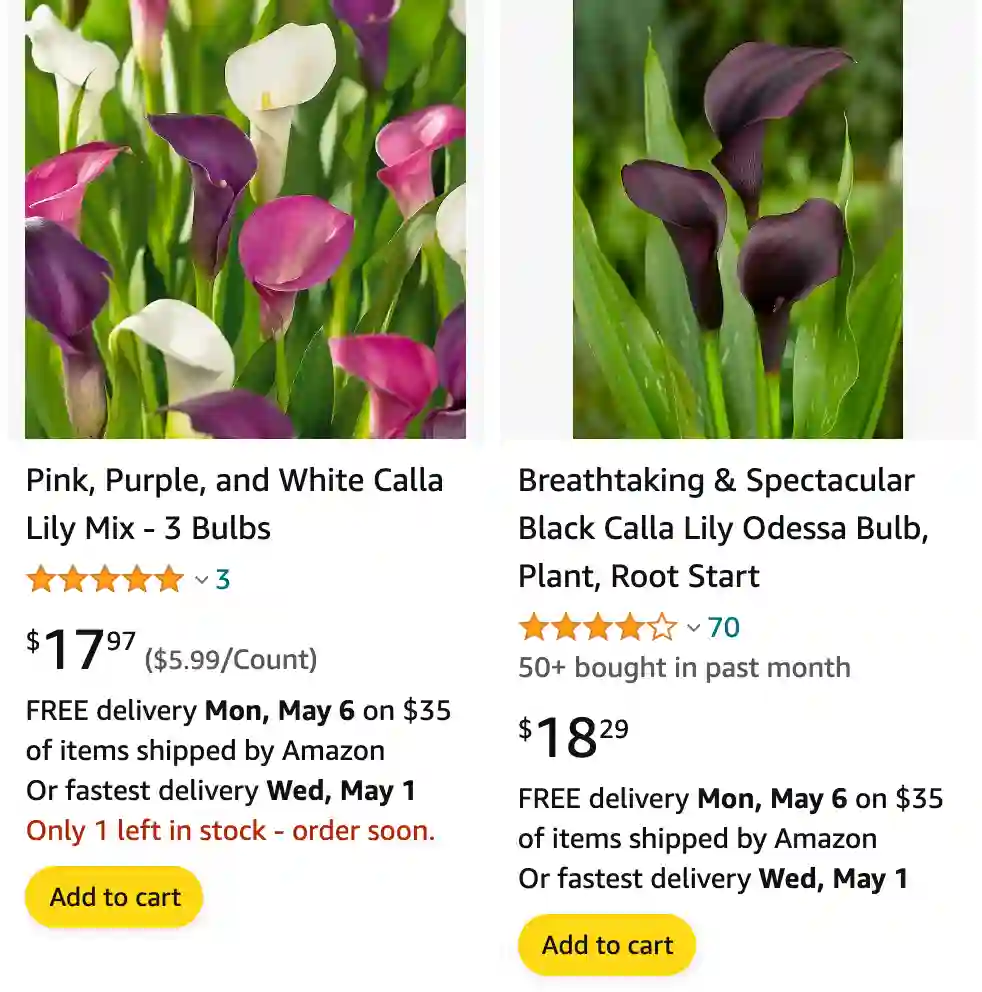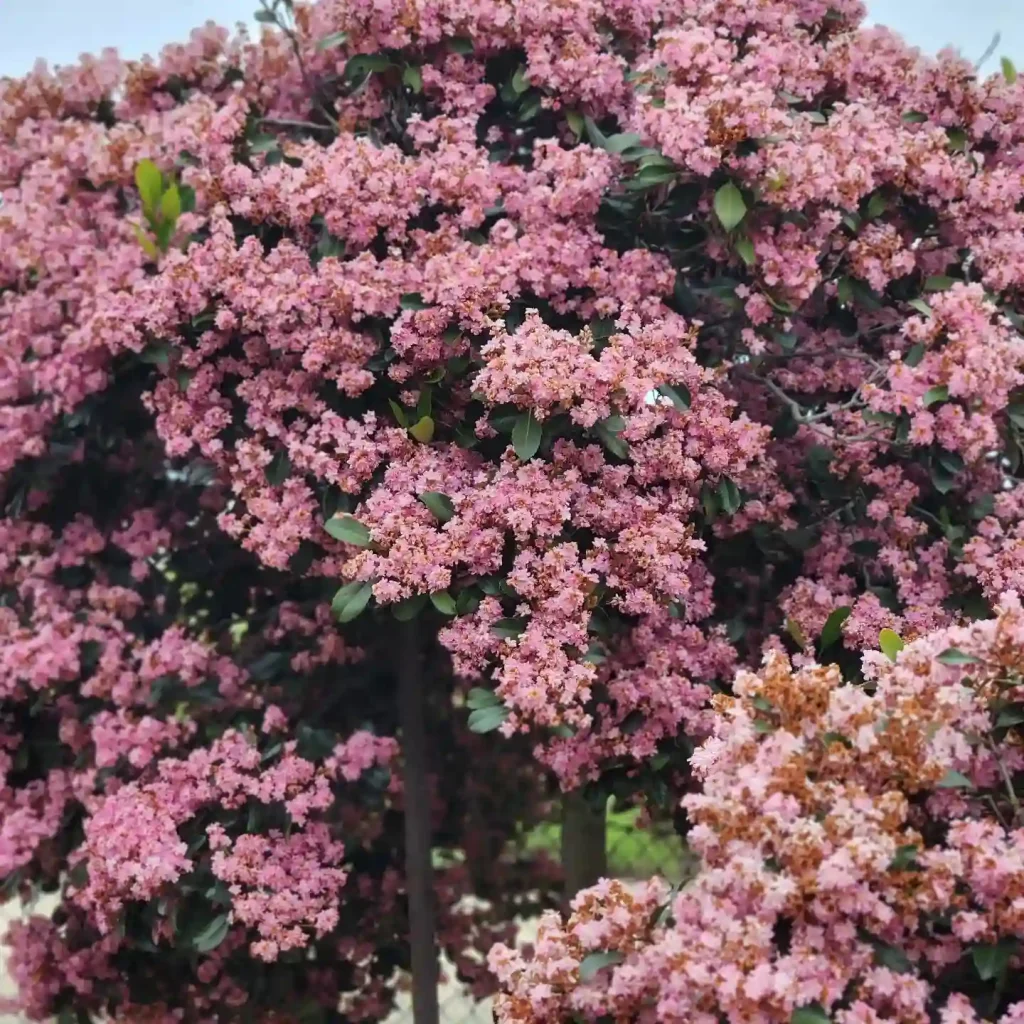
Do deer eat calla lilies?
No way, deer wouldn’t touch my calla lilies! Last year, I planted a whole row of them along the back fence, thinking they’d add a pop of color. My neighbor, who’s been battling deer in her garden for years, warned me they’d be gone by nightfall. But guess what? Those calla lilies thrived all summer, with their big, beautiful blooms practically brushing the fence. Not a single bite mark. Maybe it’s the location, right next to the fence line where the deer feel less comfortable lingering, or maybe there’s something about those calla lilies they just don’t like. Whatever the reason, they were the peace lilies of my garden – deer-free and fabulous!
Are calla lilies toxic to cats?
My calla lilies are gorgeous, but I wouldn’t let my cat anywhere near them. I learned this the hard way a few years ago. It wasn’t a full-blown poisoning, thankfully, but Luna definitely wasn’t herself after nibbling on a calla lily leaf. She drooled excessively, seemed to be in mouth pain, and went off her food for a bit. It was a scary night, with lots of worried Googling and pacing until she seemed to perk up again. It definitely convinced me to keep those beautiful blooms out of her reach. Now, they grace the sunny windowsill in the living room, far away from any curious kitty paws. It’s a shame, because I love having fresh flowers around, but Luna’s safety comes first.
What do calla lilies represent?
For me, calla lilies have always walked the line between elegance and mourning. Their tall, graceful stems and smooth, trumpet-shaped blooms are undeniably beautiful, perfect for a sophisticated centerpiece or a splash of color in the garden. But there’s also a quiet solemnity to them, which is why I often see them in funeral arrangements. Maybe it’s the association with Easter lilies, or the simple, almost stark beauty of the flower itself. Either way, for me, calla lilies represent a kind of hopeful reverence – a reminder of both life’s fragility and its enduring beauty.
How often to water calla lily?
My calla lilies can be a bit fussy when it comes to watering. Finding the sweet spot between thirsty and soggy takes some practice. Generally, I aim for a good soak once a week, letting the water drain completely out the bottom of the pot. Sticking my finger in the soil up to the first knuckle is my trick – if it feels dry, it’s watering time! During the summer heat, I might sneak in an extra sprinkle every now and then, especially for the calla lilies in pots that dry out faster than the ones nestled in the ground. But I’m always careful not to go overboard. Overwatering is a recipe for disaster with these guys, leading to mushy roots and sad, droopy blooms. So, one good soak, a finger check, and maybe a bonus sprinkle in the heat – that’s my calla lily watering motto!
Can a calla lily grow indoors?
Absolutely! My calla lilies thrive indoors, even though they’re technically outdoor plants. They love the bright, indirect sunlight streaming through my east-facing windows. Keeps them happy and flowering for weeks on end. I just make sure to rotate the pot every few days so all sides get some sun love. The trickiest part for me is mimicking their natural moisture levels. My house can get a bit dry in the winter, so I use a pebble tray filled with water under the pot to keep the humidity up. And forget about letting the soil dry out completely – these guys are practically little water fountains! A good soak once a week, with the pot draining well, seems to do the trick. Overall, calla lilies have become surprising indoor superstars in my house – beautiful blooms without the hassle of battling the elements.
Why are my calla lilies drooping?
There are a couple of things that could be making your calla lilies droop. Let’s think it through. Have you checked the soil lately? Calla lilies love moisture, but if they’re swimming in water, their stems get weak and droopy. Sticking your finger in the soil is a good trick – if it feels dry to the first knuckle, it’s watering time. But if it’s soggy, hold off and let things dry out a bit. Overwatering is a common culprit with these guys.
On the other hand, maybe your calla lilies are feeling parched! Especially if it’s been hot and sunny lately. They like a good, deep soak once a week, so if they haven’t had a drink in a while, that could be why they’re drooping. Give them a good watering and see if they perk up in a day or two.
Can calla lily grow in water?
Calla lilies can actually surprise you with their adaptability! While they’re not truly aquatic plants, they can tolerate wet feet and even thrive in shallow water conditions. I’ve seen them grace the edges of ponds with their elegant blooms, the crown of the plant just above the water line. Their roots seem happy absorbing moisture directly from the water, as long as the soil isn’t completely submerged. This might be a good option if you want to create a beautiful water feature but don’t want to deal with the mess of traditional pond plants. Just remember, they’ll still appreciate some regular watering to keep the top part of the soil moist.
What do calla lilies signify?
Calla lilies in my house are like chameleons, changing their meaning depending on the occasion. For birthdays, their clean lines and vibrant colors – especially the yellows and pinks – feel celebratory. They add a touch of modern elegance to a gift bouquet. But come Easter Sunday, those same white calla lilies transform into symbols of purity and renewal, gracing our brunch table. Perhaps it’s because they share some resemblance to Easter lilies, or maybe their simple beauty just evokes a sense of springtime awakening. And then there are the quieter moments. A single calla lily in a bud vase by a sick friend’s bedside expresses sympathy and hope for recovery, its white bloom a quiet beacon of peace. Calla lilies may not have just one meaning, but for me, they represent a beautiful versatility, adapting their message to whatever sentiment I need them to convey.
When do calla lilies sprout?
In my experience, calla lily sprouts are patient little things! It can take a good two weeks or even longer after planting for those first green shoots to peek through the soil. Don’t lose hope! Just make sure you planted them in a spot with well-draining soil and some good sunlight, and keep that soil evenly moist (but not soggy) Once those sprouts appear though, it’s like magic. The calla lilies grow surprisingly quickly, rewarding your patience with beautiful blooms in a few short months. Just hang in there and those sprouts will surprise you!
Why are my calla lily leaves turning yellow?
There are a couple of reasons why your calla lily leaves might be turning yellow, and figuring it out can help you get your beautiful flowers back on track.
One possibility is that it’s just part of the natural cycle. Calla lilies aren’t evergreen, and as they get towards the end of their flowering season, the leaves will naturally start to yellow and die back. This usually happens after the blooms have faded. If this is the case, there’s no need to worry – it just means it’s time to cut back the old foliage and let the plant rest.
However, if your calla lily is still producing blooms or seems weak overall, then the yellowing leaves could be a sign of a problem. The most likely culprit is overwatering. Calla lilies love moisture, but like most plants, they don’t like sitting in soggy soil. This can lead to root rot, which disrupts the plant’s ability to take up nutrients and water, causing the leaves to yellow.
To check for overwatering, stick your finger into the soil. If it feels wet or mushy down to your first knuckle, then hold off on watering for a while. Let the soil dry out a bit, and then water deeply when the top inch or so of soil feels dry.
If you’re worried about root rot, you can carefully remove the calla lily from its pot and inspect the roots. Healthy roots should be white or cream-colored and firm. If the roots are brown, mushy, or smell bad, then root rot is likely the culprit. In this case, you’ll need to take some action to save your plant.
Do hummingbirds like calla lilies?
That’s an interesting question! Here’s the thing: calla lilies aren’t exactly hummingbird magnets. They lack the flashy, open blooms hummingbirds typically favor. Calla lilies have a more elegant, trumpet-shaped flower with a central spadix that doesn’t offer easy access to nectar.
However, there are some mixed reports online. Some gardeners claim hummingbirds visit their calla lilies, while others haven’t had any luck. It’s possible that certain calla lily varieties, particularly those with lighter colors or a wider opening at the bloom, might be more attractive to hummingbirds.
In my experience, I haven’t personally spotted hummingbirds buzzing around my calla lilies. But that doesn’t mean yours won’t attract them! If you’re hoping to create a hummingbird haven in your garden, I’d recommend planting some tried-and-true hummingbird favorites alongside your calla lilies. Bee balm, trumpet honeysuckle, and fuchsia are all known to be irresistible to these tiny, feathered jewels.
How to harvest calla lily seeds?
Ah, harvesting calla lily seeds can be a fun and rewarding experience, especially if you’re looking to expand your calla lily collection or share the joy of these beautiful flowers with friends. Here’s what I’ve learned from my own experience:
Patience is Key: Don’t expect overnight results. After the blooms fade, the calla lily will produce a seedpod at the base of the flower stem. This pod will take several weeks, maybe even a month or two, to mature fully. You’ll know it’s ready when the pod changes color from green to a light brown or yellow-tan, and feels dry and papery to the touch.
Keep an Eye on the Prize: As the seedpod dries, watch it closely. You don’t want to harvest it too early when the seeds are still developing, but you also don’t want to wait too long until the pod splits open and scatters its precious cargo all over the garden!
Snip and Save: Once the pod feels dry and has reached its mature color, use sharp shears or pruners to carefully cut the stem just below the pod. This will prevent any damage to the seeds while you harvest them.
Separate and Clean: Bring your harvest indoors and find a well-ventilated area to work. Gently remove the pod from the stem and break it open. Inside, you’ll find the calla lily seeds – they’ll look like small, flat, black discs. You might also see a fleshy orange or red aril around some of the seeds. This is a natural coating and can be gently rubbed off with your fingers.
Drying is Crucial: Spread the seeds out on a paper towel or paper plate in a single layer. Place them in a warm, dry location with good air circulation, but out of direct sunlight. Aim for drying them for a week or two, until they feel completely dry and firm to the touch.
Seed Storage: Once your calla lily seeds are fully dry, store them in a sealed paper envelope or airtight container. Label the container with the date and variety (if known) so you have all the information come planting time. Calla lily seeds can stay viable for several years when stored properly in a cool, dark location.
Now you have your very own calla lily seeds ready to be planted and grow into beautiful new flowers! Just remember, germinating calla lily seeds can take some time and patience, but the satisfaction of nurturing your own plants from seed is truly rewarding.
How to plant calla lily seeds?
Planting calla lily seeds can be a bit more involved than just sticking them in the ground and hoping for the best. But fear not, with a little care and attention, you can coax those tiny seeds into beautiful blooms. Here’s what I’ve learned through my own trial and error:
Seed Prep Can Help (Optional): Some gardeners swear by pre-soaking calla lily seeds for a day or two before planting to encourage germination. You can try this if you’d like. Just place the seeds in a shallow dish with lukewarm water and let them sit for 24-48 hours.
Pick the Perfect Pot: Seedlings are delicate, so opt for small pots with good drainage – around 3 inches in diameter will do. Fill them with a well-draining seed starting mix. Make sure the pots have drainage holes to prevent waterlogging.
Planting Time: Sow the seeds one per pot, gently pressing them just slightly into the moist soil surface. Don’t bury them deeply – they need light to germinate. Lightly water the soil to settle everything in.
Warmth and Moisture are Key: Place the pots in a warm location, ideally with temperatures around 70°F (21°C). Cover the pots with clear plastic wrap or a humidity dome to create a mini greenhouse environment. This will help retain moisture and promote germination.
Patience is Paramount: Don’t expect sprouts overnight! Germination can take anywhere from a few weeks to a month or even longer. Keep the soil consistently moist but not soggy – a spray bottle can be helpful for watering here. During this time, peek under the plastic wrap occasionally to monitor moisture levels and air circulation. If condensation builds up excessively, remove the cover for a short time to allow for some fresh air exchange.
Light Up Their Lives: Once those first green shoots appear, it’s time to gradually introduce them to brighter light. You can remove the plastic wrap or humidity dome at this point. Place the pots near a sunny windowsill, but be careful of direct afternoon sun which can scorch the delicate seedlings.
Transplanting Time: As your calla lily seedlings grow and develop a few sets of true leaves, you can transplant them into larger pots or even directly into your garden bed if the danger of frost has passed. Harden them off gradually by taking them outdoors for increasing periods of time each day before making the final move.
Blooming Beauty (Eventually): Keep in mind that calla lilies grown from seed can take a while to flower, sometimes up to 3 years. But with proper care and a little patience, your perseverance will be rewarded with those stunning blooms you’ve been waiting for.
How to transplant calla lilies?
Transplanting calla lilies can be a breeze if you know the right steps! Here’s what I’ve learned from my own experience moving these beauties around the garden:
Timing is Crucial: The best time to transplant calla lilies is when they’re dormant, typically in the fall after the foliage has died back or in early spring before new growth emerges. Avoid transplanting during the hot summer months when the plant is actively growing and flowering, as this can stress it out.
Prepare the New Home: Before you even touch the calla lily, get its new digs ready. Choose a location with well-draining soil and plenty of sunlight, at least 6-8 hours a day. If your soil is heavy clay, amend it with some compost or organic matter to improve drainage.
Hydration is Key: A good watering a day or two before transplanting helps loosen the soil and makes it easier to remove the calla lily without damaging the roots.
Careful Does It: When it’s time to move the calla lily, use a shovel to carefully dig a wide circle around the base of the plant. Go deep enough to get the entire root ball, which can extend outwards further than you might think. Aim to lift the calla lily with as much soil attached to the roots as possible.
New Home, New Hole: Dig a hole in the new location that’s large enough to accommodate the root ball without crowding. Gently place the calla lily in the hole, ensuring the crown (the area where the roots and stems meet) sits at the same level it did in the previous location.
Fill and Fluff: Fill the hole back in with the excavated soil, gently tamping it down to remove air pockets. Water the transplanted calla lily thoroughly to settle the soil around the roots.
Aftercare is Important: Keep the transplanted calla lily well-watered for the first few weeks, especially during dry periods. This will help the plant establish itself in its new location. You can also add a layer of mulch around the base of the plant to retain moisture and suppress weeds.
With some care and attention, your transplanted calla lily should settle in nicely and reward you with beautiful blooms for seasons to come!
Do you deadhead calla lilies?
You don’t necessarily have to deadhead calla lilies in the way you might other flowering plants, but it can be beneficial for a couple of reasons. Here’s what I’ve found from my experience:
Natural Beauty vs. Seed Production: Calla lilies won’t necessarily produce more flowers if you deadhead them. Unlike some plants, they have a predetermined number of blooms they’ll produce each season. However, deadheading can still be a good idea for maintaining the overall appearance of the plant.
Seed Pods vs. Flower Power: Once the calla lily flower fades, it will start to form a seed pod at the base. If you leave this on, the plant will focus its energy on producing seeds rather than putting on a new flower show. By removing the spent flower head (deadheading), you encourage the plant to divert its energy towards maintaining healthy foliage and potentially producing a new flower stalk, although this isn’t guaranteed.
Look Out for the Littles: Calla lily seeds can be messy! If you don’t want them scattering around your garden or don’t plan on saving them for planting, deadheading prevents the seed pod from forming altogether.
How to Deadhead: When a calla lily flower starts to fade and wilt, you can simply pinch it off at the base of the flower stalk, or use sharp pruners to make a clean cut. Just be careful not to accidentally snip off any new growth that might be emerging nearby.
So, while deadheading calla lilies won’t necessarily lead to an explosion of blooms, it can help maintain the plant’s appearance, encourage continued flowering, and keep things tidy in the garden. It’s a personal choice, but I tend to deadhead mine to keep them looking their best throughout the season.
How to cut calla lilies for vase?
Absolutely! Here’s how I cut my calla lilies for stunning vase arrangements:
- Sharpness is Key: Grab some sharp pruning shears or floral scissors. Dull blades can crush the stems, hindering water uptake and shortening the life of your blooms.
- Bloom Time: The best time to cut calla lilies for a vase is when the flower head is just starting to unfurl, but the colorful spathe (the trumpet-shaped part) feels firm and smooth. Avoid blooms that are fully open or have started to droop.
- Size Matters: Measure your vase to determine the ideal stem length. You want the blooms to gracefully extend from the vase, with some room for foliage at the base. Aim for a cut that leaves 1/2 to 2/3 of the stem length in the vase.
- Angle Your Attack: For optimal water absorption, cut the stem at a 45-degree angle with a clean snip. This creates more surface area for the stem to draw up water.
- Water Wise: Immediately after cutting, plunge the stem an inch or two underwater. This helps prevent air bubbles from forming in the stem, which can block water flow.
- Foliage Focus (Optional): You can include a few calla lily leaves for a more vibrant arrangement. Just be sure to remove any leaves that will fall below the water line in the vase, as these can decompose and create bacteria.
- Vase Prep: Choose a clean vase and fill it with fresh, cool water. You can add a packet of floral preservative if you have it, as this will help nourish the flowers and extend their vase life.
With these simple steps, your calla lilies will be ready to shine in a stunning vase arrangement, bringing elegance and beauty to your home!
How to make calla lily bloom?
There’s no guaranteed method to make your calla lilies bloom instantly, but here are some things you can try to encourage blooming and troubleshoot potential issues:
Light Up Their Lives: Calla lilies are sun-loving plants. They need at least 6-8 hours of bright, indirect sunlight daily to thrive and produce blooms. If your calla lilies are planted in an area with too much shade, consider transplanting them to a sunnier location. You can also supplement with artificial lights if needed.
Water Wisely: Finding the watering sweet spot is crucial. Calla lilies love moisture, but they don’t want to sit in soggy soil. Aim for a good soak once a week, letting the water drain freely from the pot or planting bed. Stick your finger in the soil to check moisture levels – if it feels dry to the first knuckle, it’s watering time. Overwatering is a common culprit for calla lilies that refuse to bloom.
Feed Me!: During the growing season, a light feeding with a balanced fertilizer every few weeks can give your calla lilies the nutrients they need to produce blooms. However, avoid over-fertilizing, especially with nitrogen-rich fertilizers, as this can promote foliage growth at the expense of flowers.
Patience is a Virtue: Depending on the variety and planting time, calla lilies may take anywhere from 6-10 weeks to flower after planting. So don’t despair if you don’t see blooms immediately. Just ensure they’re getting proper light, water, and nutrients, and those beautiful flowers should eventually appear.
Dormancy Matters: Calla lilies are technically bulbs and go through a dormant period in the winter. During this time, they won’t be actively growing or flowering. In colder climates, you might need to dig up the bulbs and store them in a cool, dry location over winter before replanting them in the spring.
Check for Pests or Disease: While calla lilies are generally fairly resistant to pests and diseases, problems can occasionally arise. Inspect your plants regularly for signs of insects like aphids or thrips, or fungal diseases. Addressing these issues promptly can help keep your calla lilies healthy and encourage blooming.
By following these tips and providing optimal growing conditions, you can increase your chances of enjoying beautiful calla lily blooms throughout the season. Remember, a little patience and TLC can go a long way with these elegant flowers!
How to repot calla lilies?
Repotting your calla lilies is a breeze if you follow these steps! It gives them fresh space to grow and thrive, potentially leading to more blooms. Here’s what I’ve learned from my own experience:
Know When to Move: The best time to repot calla lilies is during their dormant period, typically in the fall after the foliage dies back or in early spring before new growth appears. Avoid repotting during the hot summer months when the plant is actively growing and flowering.
Prepare the New Place: Choose a pot that’s only a couple of inches larger in diameter than the current one. Calla lilies tend to flower better when slightly root-bound. Make sure the new pot has drainage holes to prevent waterlogging. You can also fill it with fresh, well-draining potting mix.
Hydration is Key: Water the calla lily thoroughly a day or two before repotting. This loosens the soil and makes it easier to remove the plant without damaging the roots.
Gentle Does It: Carefully tip the old pot on its side and gently tap the rim to loosen the calla lily. You can also run a butter knife along the inside edge of the pot to help detach the root ball. Once loose, slowly slide the calla lily out of the pot.
Root Check (Optional): Take a quick peek at the root ball. Healthy roots are white or cream-colored and firm. If you see brown, mushy, or smelly roots, you might be dealing with root rot. In this case, you’ll need to remove the damaged roots before repotting.
New Home, New Soil: Place the calla lily in the center of the new pot. Fill in the gaps around the root ball with fresh potting mix, gently tamping it down to remove air pockets. The crown (where the roots and stems meet) should sit at the same level it did in the previous pot.
Water Wisely: Give your repotted calla lily a good watering to settle the soil around the roots. Avoid overwatering in the following weeks, as the roots are still establishing themselves in the new pot. Water when the top inch or so of soil feels dry to the touch.
Post-Repot TLC: Keep your repotted calla lily in a warm location with bright, indirect sunlight. It might take a few weeks for the plant to adjust to its new home, so don’t be surprised if some of the foliage looks a little droopy. With proper care, your calla lily should bounce back soon and reward you with beautiful blooms in the coming season.




